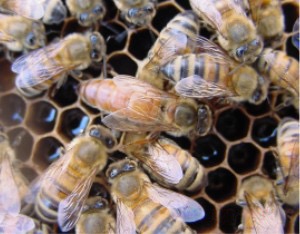You don’t have to see a queen bee to know she’s there.
Lately, the North Central Washington Beekeepers’ Association‘s mailing list has been flooded with a rash of panicky reports from members that claim they have a queenless hive. In nearly every case, the beekeeper has made this determination because he or she simply has not seen the queen.
Fortunately, you don’t need to see the Queen among the rest of the bees to know that there is a queen in the hive. I say “fortunately” because I rarely see the queen in my hives, yet I know that she’s in there.
At the beginning of this season, I obtained two nucs and four packages. In each case, I introduced the queen to the rest of the hive by prepping her queen cage and letting the other bees release her. (And yes, I know a “real” nuc should have an established queen — how I got these is a story in itself.) So I know I started with a live queen in each hive.

Image of queen bee by Pollinator on Wikipedia. Used with permission; Creative Commons 3.0 license.
Yet on my first inspection, I found no sign of a queen in two of my four packages or either nuc. I thought I had a disaster on my hands and started researching how I could get new queens quickly, before the colony died, without driving to Seattle or spending a fortune.
In this case, my slow response paid off. I inspected the “queenless” hives again and found evidence that there was a queen present, even though I didn’t see the queen. All the hives are doing well; I didn’t have to replace any queens.
Now I don’t want to suggest that I’m an expert — I’m not. This is only my third year as a beekeeper and I never even completed the beekeeping course offered by the group. Yet it seems to me that there’s one pretty positive indicator that a queen is present, even when you don’t see her:
Are there eggs?
Pretty simple stuff. If there are unhatched eggs, you know there was a queen in the hive within the past three days. Why? Because it take three days for an egg to hatch.
Now yes, it’s true: when a hive is queenless it is possible for workers to lay infertile eggs. But how often does that really happen?
If you don’t see eggs, are you looking hard enough? I never saw a bee egg until this year. Why? Well up until this year, I had my contact lenses set up for near and far vision. Unfortunately, although I could see okay near and okay far, I didn’t see well either way. So this year I decided to use the contacts for far vision and wear readers for close vision. All of a sudden I could actually see tiny things again! Like bee eggs! So if you’re 40+ years old and your close vision isn’t perfect, don’t expect to see bee eggs without a pair of glasses to help. Put them on under your veil.
Black foundation also helps. The tiny white eggs — much smaller than a grain of rice! — show up much better against black than yellow. Mann Lake and other beekeeping supply houses sell black foundation just for this reason. See for yourself here.
If you still don’t see bee eggs, look for freshly hatched larvae. Those are only a few days old. If you see some tiny larvae today and look again a few days later and see more around the same size, there probably were eggs in there that you just didn’t see. And a queen laid them. Thus, there is a queen in the hive.
Right now, I’m caring for seven hives. I don’t do hive inspections as often as I should — I only get in there about once a month — and this year I’ve probably only done about twenty hive inspections. Yet I’ve only seen a queen four or five times. And in two of my hives, the queen is marked!
Remember, there are thousands and thousands of bees in each hive. If you’re set up with two or more supers and twenty of more frames, do you honestly think you’ll be able to spot the queen in an 30-minute inspection? I don’t. And although I keep an eye out for her as I examine each side of each frame, I don’t waste time searching for her.
It’s more important to assure that the colony is healthy with plenty of brood and food stores than to look for the boss lady that makes it all work.
That’s how I look at it anyway.
Discover more from An Eclectic Mind
Subscribe to get the latest posts sent to your email.